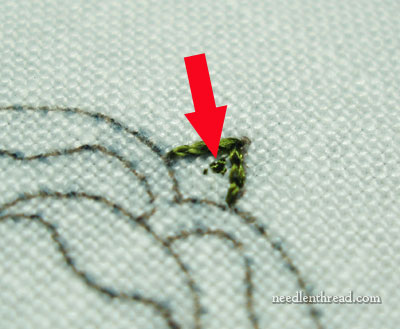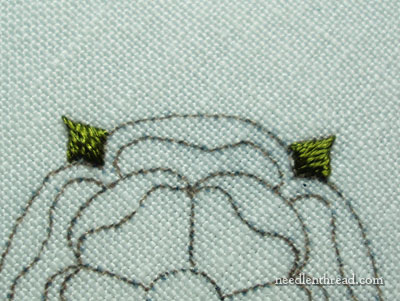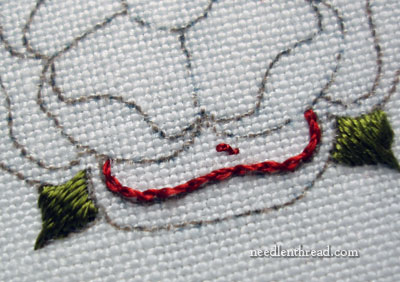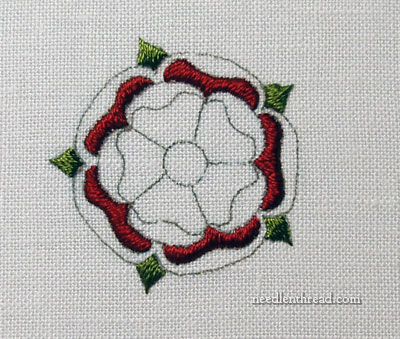As promised, here’s the beginning of step-by-step stitching instructions for the goldwork & silk Tudor-style rose. You’ll find all the tutorials for this embroidery project listed in order under the Goldwork & Silk Embroidered Tudor-Style Rose Index listed on the Tips & Techniques page.

If you’re just checking in on this and you want to stitch the project, you can download the embroidery pattern for the Tudor-style rose and use whatever size you want to work. My original size was the small 1.5″ round rose, so the stitching that I’m doing in this step-by-step tutorial fits in that size piece. If you work a larger sized rose, you’ll need to adjust your stitching to fit the size of your design.
These instructions are simply to show you how I went about stitching this piece. You can certainly customize yours if you wish – switch up the colors however you wish, or select different types of threads, etc.
These are the materials I used for my version:
Au Ver a Soie Silks:
Soie de Paris, in four colors: 2134 (green – or you can use 2214, which is a bit darker); 4624 (dark red); 2914 (pink / rose); & creme
Soie 100/3, color #518
Soie Gobelins, color #2646
Metal Threads
Gold Tambour Thread #7
Check Thread #7
Pearl Purl, size Super
Gilt Wire Check #10

First step: transfer your design to your fabric of choice. You can use whatever embroidery transfer method you prefer, and whatever ground fabric you prefer, but the ground fabric should be sturdy enough to accommodate metal thread embroidery, if you’re using metal threads.
I used a nice linen woven specifically for embroidery, called Alabaster Angel by Legacy Linen. You can find this linen at a number of fine embroidery shops online. I lined my linen with a good quality white muslin.
To transfer my design, I used the prick & pounce method. This way, I had a pricked “template” ready for repeat transfers (I’ll be doing five more of these in the days to come). After applying the pounce powder, I used a micron art pen to “connect the dots.” Easy-peasy, and it worked really well.

When working a combination of silk embroidery and goldwork, it’s normal to do all the silk embroidery first, so that your silk threads don’t catch on any metal threads while you’re stitching.
The leaves are the first thing to tackle. I’m using Soie de Paris #2134, a filament silk with a soft twist. It’s a beautiful thread, and great for this type of embroidery.
For all of the silk embroidery on this piece, you’ll want to anchor your thread with small tacking stitches in an area that will be covered up with other stitches. For the leaf, I made my tacking stitches right in the middle. Knot your thread, go down into the fabric from the top of your work, make three tiny stab stitches to anchor your thread, and then cut the knot off. Your thread will be secure.

To stitch the leaves on this design, please refer to this tutorial on stitching to a point with satin stitch. I used these leaves to demonstrate stitching to a sharp point with satin stitch, so you’ll want to follow those directions if you want to stitch the leaves the same way.

Once all five leaves are finished, you’ll move on to the inside of the outside petals. This part is stitched in satin stitch, in dark red Soie de Paris, #4624. Begin with a split stitch line only on the top edge of the inside of the petal (refer to the line shown in the photo above). Do not split stitch the inside edge of the petal. I stitched my split stitch line just inside the pattern line, instead of right on it, because I want my satin stitch to end exactly on the pattern line.

After split stitching along that outside edge of the petal, it’s time to satin stitch the petal. Bring your needle up in the middle of the inside edge of the petal, in the little “valley” at the intersection of the inside petals of the flower. For this satin stitching, you’ll always bring your needle up on the inside edge of the petal and take the needle and thread down over the split stitch line.
As you take your needle into the fabric over the split stitch line, make sure you’re on the design line, not outside it, and not inside it. Just work right on the line, up against your split stitch outline, and if you need to, slant your needle underneath the split stitch a tiny bit, pointing towards the middle of the flower. This helps lift the outside of this petal and creates a nice smooth edge. The lifting of this edge also helps create a little illusion of a darker color on the outside of the petal, due to the shadow created by the satin stitch.

Satin stitch from the middle to one end of the petal, and then go back to the middle and stitch to the other end. For these outside petals, there is no angle. You’re just satin stitching straight across the petal, without any slant.

You can see here that the stitches aren’t slanted.

Continue with the other five outside petals in the same exact way.
Remember when working the satin stitch that you want your stitches lying parallel to each other, right next to each other, not overlapping, but not far enough away to leave a space. Sometimes, it takes a little doing to get the spacing correct on satin stitch, but take your time and work it slowly. With a little practice, you’ll find it pretty easy to make a nice satin stitch!
Another point about satin stitch – some threads just make a better satin stitch. Soie de Paris happens to make a Really Nice satin stitch! But you might be working with different threads. If you’re working with stranded cotton, I suggest working the satin stitch in one strand of floss, even if you’re working a larger version of the flower. One strand always makes a better finish on satin stitch.
If you’re working a larger version of the design – say you’ve enlarged the design to 3″ or more – you’ll actually have plenty of room in these outside petals to do some long and short stitch and use more than one color. Doing so will give the petals some nice depth. The 1.5″ version is too small to manage two rows of stitching with this particular thread, but larger versions should accommodate two more more rows more easily.
Next, I’ll show you the inside of the inside petals of the flower in long & short stitch, and then we’ll tackle the goldwork!
If you’d like to see this entire project worked step-by-step, feel free to visit the complete list of tutorials in the Goldwork & Silk Tudor-Style Rose instructional series.
If you have any questions or comments, feel free to leave them below!







Lovely design, lovely threads and a great tutorial! Looks somewhat like the Yorkshire Rose, albeit not white, which is the symbol of the area I live.=) OK, Lancastrians, as it’s red, it’s more like the Lancashire Rose!!=)
Hi Mary, I am very interested in this project. I was wondering if this Tudor Rose will be part of a larger finished project. If so, could you give us an idea of what the final overall project will be? Thank you. Your work is beautiful.
Hello Eileen:
The original Tudor Rose was a blend created from the Red and White Rose symbols of the houses of York and Lancaster. the original blend was created when Henry VII married Elizabeth of York after the wars of the roses, ergo, the Tudor Rose. oops i guess you know that since you’re from Yorkshire. sorry, i’m a medieval history buff and my biggest area of interest is the tudors..i don’t know if Elizabeth of York created the first ones in her own embroidery or if her seamstresses did….
Mary,
I was very excited when I saw you were going to set up a tutorial on this. Hope to get started on it in a week or two. I am going to give it a try with some muslin fabric and DMC cotton threads.
Thanks again!
This is great thanks for the tutorial! I have most of thre materials in my stash. I’ve wanted to do an Tudor rose for awhile. Now no excuses
best wishes
Audrey
Hello Mary,
Thanks for these detailed informations. I think I will give it a try this summer. Maybe I will change the color scheme, to use what I have in stock 😉
Regards
Hi Mary, 🙂
This is just a fabulous tutorial.
I’m doing my Bishop’s Cope project soon, with Pearsall’s Filoselle (first time I’ve worked in silk, except that thin YLI). It has 3 Tudor Roses on it.
I was already going to swop out one Rose for a pattern from Lynette Hale (I got her permission) and I’ll use yours for a second one, as it’s slightly different.
They’ll be about 1″ across.
Thankyou MUCHLY – a beautiful pattern, wonderful instructions, and right on time for me, as I’m designing the cope piece at the moment.
KUDOS!
I wish i had a Face to Face Tutorial…
Jim
Hi Mary, Thanks for the detailed instructions. A question though. When you used the Soie de Paris, how many strands are you using at one time? All six seems so heavy.
Thanks,
Karen
Hi, Karen – It’s one strand at a time. Sorry I didn’t specify that! ~MC
This is great work. Will definitely try it out once. The design has an elegance and rich look…!
Wonderful work ! Amazing
Dear Mary,
i dont have internet access at home and have to access your website at my local library. is it possible to download and print the tutorials for a project so that i can work on it at home?
Thank you for your wonderful site,
regards,
Allison
Hi, Allison – the printer icon at the top of the left column can help you print things out, but make sure that, in the print preview that pops up, you choose the pages you want to print, rather than printing the whole thing. You can also highlight, cut, and paste text into a document and print it that way. Hope that helps! ~MC
Hi Mary, I was curious if you could use the Soie Gobelins (Pardon my misspelling) for the silk shading? It’s finer than the Ovale and I’m not sure how well it well work.
Hi, Mattie – Soie Gobelins is a tightly twisted thread, so it doesn’t blend as easily when shading, and it will be more difficult to split than the Soie de Paris (or Soie Ovale, if you want to use a flat silk). -MC
Hi Mary,
I hope you’re feeling a little better.
Could you please give me a substitute thread for Soie de Paris? I’m trying to stitch the Silk Tudor Rose and I’m having hard time finding the thread in the colors I need.
Thanks so much,
Patti
Hi, Patti – Well, you can substitute any single-thread floss (including cotton). You won’t get the same results, but as long as you’re using a single strand of floss, you should be able to embroider the rose without a problem. You can mix up the color scheme, too. Hedgehog Handworks carries Soie de Paris, so if you want to order it online, you can find it there.
Hi Mary, I live in a rural area with no embroidery support really. I did do some classes with Jane Nicholas before i moved here but it was over 17 years ago and i stopped embroidering altogether. Now i have retired i want to pick it up again. I just need some guidance or a good reference book on the simplest way to transfer patterns onto fabric for a beginner as i feel i need to start over. Is there a good book that you can recommend please? I love everything that you put up. I read it with my cup of tea in bed every morning before i do anything else.
Thank you, Lesley Merry
Hello,
I can order only online and I am a newbie in embroidery. I manly cross stitch. I neeed a liitle help on what kind of fabric and count could be stiched the Tudor Rose? Could be stitched with Kreinik ? If so what number? Thank you very much for your help.
Hi, Rose! Thanks for your question! The tudor rose isn’t counted work, so the thread count on the fabric doesn’t matter, as long as the ground fabric is a solid weave that will support the embroidery. You can work it on any fabric, but it’s most suited to a good linen or a silk ground fabric, like silk dupioni (which you would back with either linen or cotton). I probably wouldn’t use a Kreinik metallic for this type of work. I don’t know if they come as fine as the gold passing thread used in the design. Metallic braids usually have a lot more texture and they’re not going to look the same or behave the same as real metal threads, using the techniques demonstrated in this project. Plus, the center part – which is done with the chip work in gold threads – doesn’t really have an equivalent in Kreinik metallics. If you want to adapt the whole approach, though, so that you can use metallics, you’re certainly welcome to, but I’m not able to give equivalents or substitution suggestions, since they’re completely different types of threads and they perform differently. I haven’t worked it with metallics, so I wouldn’t be of much help, I’m afraid!
It has been more than a decade since this post, but I am interested in this tutorial. I have found some of the Soie de Paris colors you gave have been discontinued. Also, how much of the metallic threads are needed for this design? I went online and found that vendors charge by the yard. Thanks.
You won’t need more than a yard of any of the real metal threads. You can substitute other colors – you’re really just looking for a gradation of red-to-pink-to-creamy-white.
Sorry Victoria – on the goldwork thread used to fill the petal tips) you might need to buy 2 yards if it’s sold by the yard (normally it comes on a spool of 10 meters, but I suppose it depends on your source), just to ensure that you have enough to work comfortably with plunging the cut ends.
Hi, do you sell the Tudor rose as a kit? with the needed threads etc
I am having a hard time finding the threads listed above
Thanks
Danila
Hi, Danila, We don’t have it at this time, but we are working towards it! I can’t give an exact time frame at this point, though. Thanks for asking!
Well, today I started embroidering the rose. I am doing a 2.5″ version. I have some observations. This is my first time working with silk. I LOVE it. I’ve worked with silk as a fabric (making stoles, burses, etc.) but never as a thread. You are so right. It makes lovely satin stitch. I am finding that I need to adjust my traced pattern a bit… no matter how hard I try, I still have trouble. I wish there were a class in tracing. I’d take it. Nonetheless, this is a totally enjoyable experience.